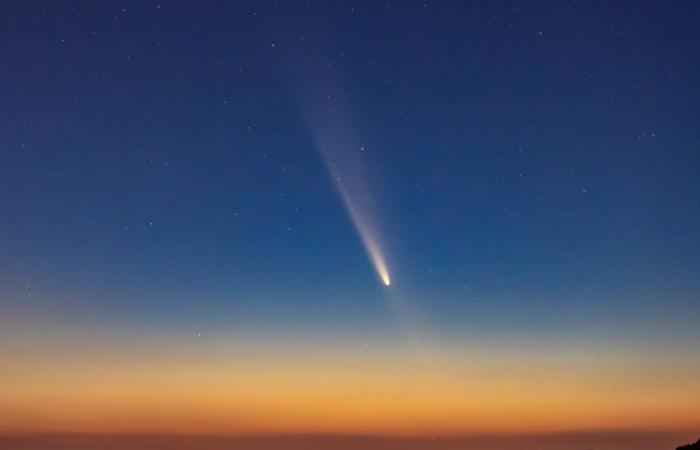
Comet Tsuchinshan-Atlas, nicknamed the comet of the century, has been visible to the naked eye since Friday October 11, 2024 in the Northern Hemisphere. Still observable until Monday October 21, it offers a fascinating spectacle just after sunset. We give you all the tips to be able to admire it or even photograph it.
You can still look up to see the comet of the century for a few days. The comet Tsuchinshan-Atlasdiscovered in January 2023, will be visible until October 21, 2024just after sunset. It is observable atœil no or with binocularstowards the west-southwest horizon. We tell you everything and give you advice on how to see it.
Why is this comet so special?
Tsuchinshan-Atlas is described as “comet of the century” by astronomers. With a core 20 to 40 kilometers in diameter, it survived its passage close to the Sun on September 27. This type of comet, visible to the naked eye, only occurs once or twice per century.
Where and how to see it?
To observe the comet, you must look in the direction ofwest-southwest horizon just after sunset, around 19h. The comet will appear low on the horizon at first, but it will gradually rise over the days until October 21. Each evening, the observation window will improve, notably thanks to earlier sunsets. To find the comet in the sky, easily with the naked eye, look west, use the tail of the Big Dipper to find in its extension a bright star, named Arcturus, the comet passes to the left of Arcturus, more or less low.
How long will the comet be visible?
It will be observable for several days, from this Friday October 11, 2024and every evening until Monday October 21, 2024. Note that maximum brightness was expected this Sunday 13 October in France. The Tuesday October 15its dust trail will be particularly luminous, forming a well-defined line, due to the crossing of its orbital plane by the Earth the day before. After this date, it will begin to lose its brightness as it moves away from the Sun, making observation more difficult without specialized equipment.
Where is the best place to observe it?
It is important to choose a site with a clear view of the western horizon, such as a hillside or an area without buildings or trees blocking the view. In the city, light pollution can hinder observation, so if possible, choose a location away from large sources of light.
Should we wait until dark?
No, it is recommended to start observing just after sunset, around 19h15 in Metropolitan France. You should not wait until it is dark, as the comet will be more visible at dusk, slightly to the left and above the point where the Sun set.
What weather factors should be taken into account?
It is imperative to have a clear sky to properly observe the comet. Clouds could block the view. Check local weather forecasts before planning your viewing.
Why is this comet interesting to scientists?
Comet Tsuchinshan-Atlas carries primitive materials from Oort clouda distant region of the solar system. By observing its tail of dust and gas, scientists hope to learn more about the composition of primordial matter which formed our solar system. This “ball of ice cream” potentially contains an invaluable scientific treasure. It offers us a unique opportunity to understand our own composition and examine what is called primordial matter. Thanks to telescopes, we could examine the composition of the matter escaping from the cometary nucleus, analyze the molecules of the plume and, thus, go back to the composition of the nucleus, revealing the fundamental elements which formed the objects of the solar system.
In short, for all those curious about astronomy, we look up to observe this exceptional comet.





